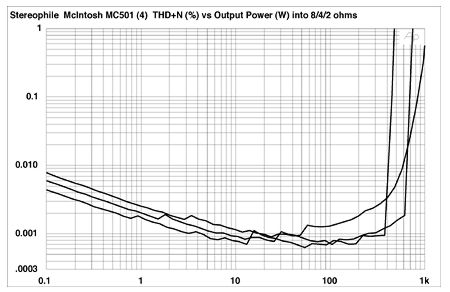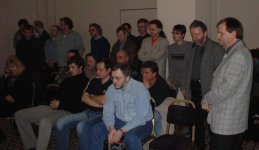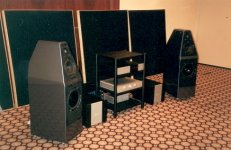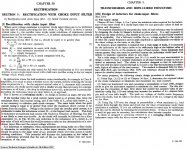I had some really old tube Mac's years ago and they always have output transformers and they seem to have carried that into their SS designs for some reason.
Sort of. Their solid state amps use autoformers, not transformers.
se
The wonders of the net - Autotransformer - Wikipedia, the free encyclopedia ...
Meanwhile the specs say "Minimum sinewave continuous average power output: 500W into 8, 4, or 2 ohms".Notice the Mac 'shut itself off after 20 mins at 30 watts rms....
Not totally dishonest, they don't explicitly claim it can do that without an ice bath.
Sorry, "continuous" doesn't mean an amp can do it 24/7 - depending on who you read it's 5 or 10 minutes with the accelerator flat to the floor, no more. We are not using the amp to run a floor heater ...
This differs from pulse power, being able to deliver higher power until the voltage rails sag to the onset of clipping.
This differs from pulse power, being able to deliver higher power until the voltage rails sag to the onset of clipping.
It couldn't do that either.Sorry, "continuous" doesn't mean an amp can do it 24/7 - depending on who you read it's 5 or 10 minutes...
Must be a bugger trying to measure something that won't stay switched on long enough to do the measurements. Maybe that explains all the steps in the distortion vs power graphs - get half way through the measurement before the amp cuts out, let it cool down for half an hour then carry on where you left off, but now the temperature's different so there's a discontinuity in the graph. Then it shuts down again, repeat 5 or 10 times until you've got a complete (but very jagged) graph.
Because it gives an idea, I guess, what the amp will do, genuinely continuously, when reproducing a normal music track - the latter never consists of a sine wave running at a constant level (unless it's a track by John Lenon, perhaps,So why use the word continuous, when it isn't!! More marketing spec to fool people.
As pointed out on the Stereophile website, a 2/3rds power setting is usually the worst heat stress on an amp - so there's every chance it would do the full power 'continuous' OK in a specified time.
Isn't there something about "Choke based PSU's" that they don't
work with class b (ab) ......
something like sustaining current ?
Yes, works best with some class-a bias , how heavy a bias? Those above floor level will have to chime in ..
Sorry, "continuous" doesn't mean an amp can do it 24/7 - depending on who you read it's 5 or 10 minutes with the accelerator flat to the floor, no more. We are not using the amp to run a floor heater ...
This differs from pulse power, being able to deliver higher power until the voltage rails sag to the onset of clipping.
Pay attn Franky , not unusual for one to sustain 15-30 watt rms when chugging along, tells me this amp would shut itself off in real world application. JA should have sounded the alarm, as they used to do in days of old when men were bold and JGH, had the steering wheel....
Last edited:
Amps of this kind are often used for very loud sound reproduction. I know at what sound level we listen when we organize a listening session of 10 - 20 high end fans in a larger listening room. Incredible! 
I agree with you, a.wayne. The amp should not shut down itself.
I agree with you, a.wayne. The amp should not shut down itself.
Attachments
Last edited:
It couldn't do that either.
Must be a bugger trying to measure something that won't stay switched on long enough to do the measurements. Maybe that explains all the steps in the distortion vs power graphs - get half way through the measurement before the amp cuts out, let it cool down for half an hour then carry on where you left off, but now the temperature's different so there's a discontinuity in the graph. Then it shuts down again, repeat 5 or 10 times until you've got a complete (but very jagged) graph.
Yep, a bit silly if you ask me .......

Not worth getting into a tit for tat about that one - I will note I made a mistake saying 2/3rds power, it's actually 1/3 power conditioning. I've looked around and seen various comments by users who have driven the MC501 unit very hard, and they've experienced no problems in the real world. Bench testing is an extremely artificial situation, and unless the tester does everything exactly right they may get misleading results.
I would much prefer an amp that finally snaps at some point of thermal overloading while working perfectly up to that point, than one that constantly collapses into a soggy mess every time a bit of genuine higher SPL is requested - the latter being the usual behaviour, unfortunately ...
I would much prefer an amp that finally snaps at some point of thermal overloading while working perfectly up to that point, than one that constantly collapses into a soggy mess every time a bit of genuine higher SPL is requested - the latter being the usual behaviour, unfortunately ...
Except that the lowest THD is reached shortly before amp goes into clipping
So you're saying that THD is important?
And do you understand what "noise" means?
edit: Sorry, I see that Pavel has already pointed this out. Knowing how to interpret measurements is important.
Except that the lowest THD is reached shortly before amp goes into clipping

I very much prefer this kind of amp behaviour:
An externally hosted image should be here but it was not working when we last tested it.
Most likely the first graph looks the same in shape as the second one if it was only for the noise. The rise of THD+N in the 1st graph towards lower levels is noise that rises above the THD which is no longer visible.
In the second graph the THD is so large that it rises above the noise so the noise is no longer visible.
You can only meaningfully compare the two graphs if they would show THD only, not THD+N.
Edit: I was shooting from the hip - I now see that others have made a similar comment. Anyway, the plot is clear
Jan
Last edited:
Linear Audio Vol 8 will have a full article on the ins and outs of rectifiers, choke and capacitor input filters and several other interesting issues. But that will be after Vol 7 which I send to the printers last Saturday
Jan
Isn't there something about "Choke based PSU's" that they don't work with class b (ab) ......something like sustaining current ?
Yes, works best with some class-a bias , how heavy a bias?
http://www.tubebooks.org/Books/RDH4.pdf
>Edit: Sorry Jan.I deleted the post and re-posted it due to some highlight I missed at the attached pic
George
Attachments
Amps of this kind are often used for very loud sound reproduction. I know at what sound level we listen when we organize a listening session of 10 - 20 high end fans in a larger listening room. Incredible!
Wow, PMA, so you do have access to highly skillful listening panel!!
Regarding amplifiers, I kind of agree with Frank that it is usually a system issue. Sometimes by changing a very little thing, a bad sound may become great. That's why even tho I have built many amps, I have no tendency to say that amp A is better than amp B.
But now I started to believe in my taste, especially after I have a firm believer in what a good speaker should sound like after my favorite speaker design successfully showed the highest potential for enjoyment for whatever recording and whatever music type.
I have championed TDA2030A for many times. This is a high distortion chip amp, but I found something "correct" with this amp compared to low distortion TDA7294 for example. This is my "taste" but like I said I started to believe that my taste is "correct"
http://www.tubebooks.org/Books/RDH4.pdf
>Edit: Sorry Jan.I deleted the post and re-posted it due to some highlight I missed at the attached pic
George
Yes, that qoute ticked me off - I just got the manuscript to that Vol 8 article and I saw the same reference.
Author is Rudolf Moers who wrote that 10 pound book on tube amplifier design
Jan
- Status
- Not open for further replies.
- Home
- Member Areas
- The Lounge
- John Curl's Blowtorch preamplifier part II


